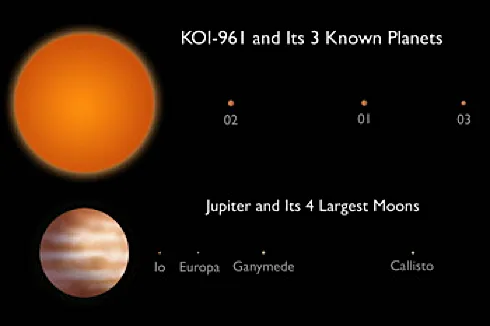
KOI-961 and its planets are analogous in size to Jupiter and its moons
Credit: NASA/JPL-Caltech
A team of US scientists headed by astronomers from the the Infrared Processing and Analysis Center at the California Institute of Technology (Caltech) have discovered the three smallest exoplanets yet known. All three appear to be ‘rocky’ planets, though it is believed they orbit their parent star too closely to lie within the habitable zone, where water can exist as a liquid on the surface of an object. Their findings were presented in a paper to a meeting of the American Astronomical Society in Austin, Texas yesterday (11 January).
The three planets orbit a small red dwarf star called KOI-961, and have been named KOI-961.01, .02 and .03. KOI-961, which has a diameter one-sixth the size of the Sun and is just 70 per cent bigger than Jupiter, isone of 900 ‘objects of interest’ being studied by NASA’s Kepler mission, of which 85 are red dwarfs. The star was initially a low priority for the Kepler mission, until amateur astronomer and paper co-author Kevin Apps noted its similarity to the nearby and well-studied red dwarf Barnard’s Star. By inferring the characteristics of KOI-961 from those of Barnard’s Star, the scientists were able to more accurately measure the star’s light curve – that is, fluctuations in the amount of light emitted by the star over the time.
It is by studying such fluctuations that Kepler is able to identify ‘planetary candidates’. In this case, three candidates were found, which have now been confirmed as exoplanets: other potential causes of dips in the star's light – such as the gravitational pull of an unseen companion star – have been ruled out. The smallest is around half the size of Earth (similar to Mars), while the other two are three-quarters Earth size (smaller than Venus). The three lie 100 times closer to their star than Earth does to the Sun, making for surface temperatures ranging from 200°C (392°F) on the outermost planet, to 500°C (932°F) on the innermost.
John Johnson, an assistant professor of astronomy at Caltech and one of the report's co-authors, said: “Red dwarfs make up eight out of every ten stars in the Galaxy. That boosts the chances of other life being in the Universe – that’s the ultimate result here. If these planets are as common as they appear, and because red dwarfs themselves are so common, then the whole galaxy must be just swarming with little habitable planets around faint red dwarfs.”